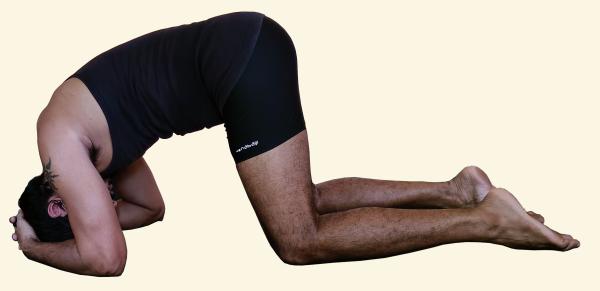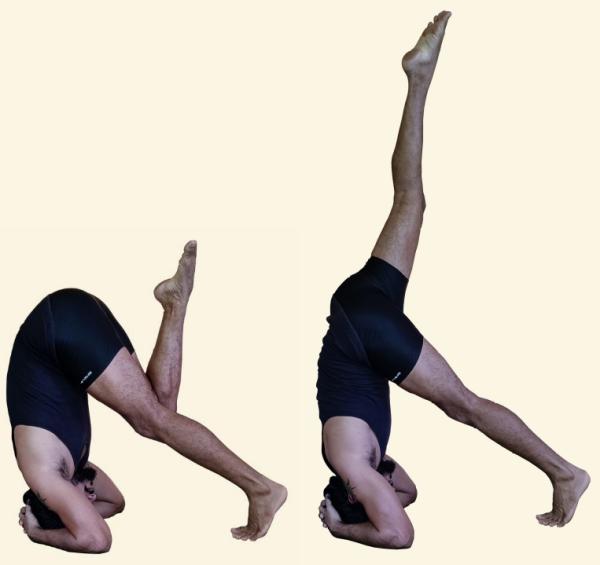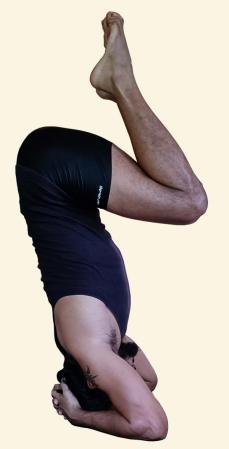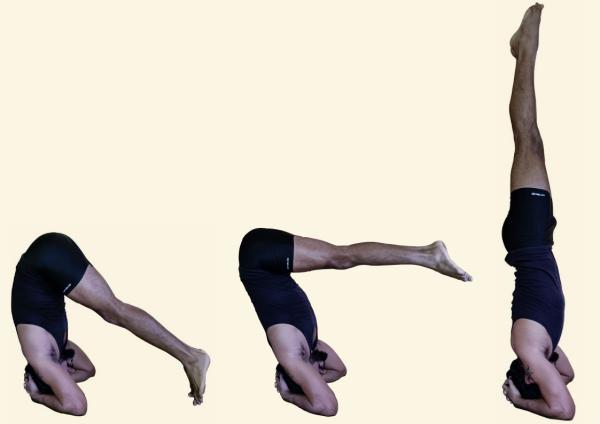This is also called Salamba Sirsasana (Salamba- supported; Sirs- head, asana- posture). The supported headstand
This is one of the poses which many yoga practitioners target to achieve. Maybe it’s because people want challenges in their life.
Being able to do a thing that you thought impossible changes your whole perspective. This creates positive energy within and gives you the power to fight those fears and obstacles that your mind has created.
Because of some of our bad life experiences, we close ourselves up and start living in our own safe shells and comfort zone. Not trying means no disappointments. You stop trying and start avoiding. This pattern can be broken by giving yourself a challenge. Even a challenge to do a headstand can break those patterns because you are proving to yourself that “it is possible”. Once you reach there it gives you intense joy and you start looking at the obstacles with a new perspective. You see that it was not about it being possible or not, it is about how much effort you put in.
Headstand is a challenging pose both psychologically and physically. The psychological aspect is the fear of falling, doubt that if you are ready, or that if you are doing it right. Sometimes psychological barrier might be way stronger than your physical barrier because it wouldn’t even let you try. Once your mind is ready the physical aspect can be taken care of, but the decision has to be made by the mind.
The fear arises from not knowing, if you don’t have knowledge of the body then every small thing happening to your body might create a lot of fear. The mind will start creating so many stories around it (and obviously a search on the internet will make it even worse, it will feed your mind with even more junk :D). The way to work on it is to know about your body, work on understanding the alignment and anatomy of the body and apply that knowledge to your practice. Do not be in a rush, just take small steps and do small experiments with your body in a safe way. Take the help of your instructor, and ask them for questions and clarification.
Do not just blindly believe people, if they say that you should not do a posture in this way, ask them why. Only accept it when it logically makes sense.
Here we will try to explain headstand and step-by-step progression to break your mental barrier. Let’s first dive into the anatomy and alignment.
The neck here is the most important part that we need to understand for this pose. Our spine is made up of vertebrae stacked on top of each other. In between the vertebrae, there is a soft round cushion that acts as a shock absorber (called the intervertebral disks). Because the weight is acting on the vertebrae, it gets important to engage the muscle so that there is no compression of these disks. If you are not engaging muscles then all the load is getting transmitted via the bones which after lots of repetition might develop some problems because of compression and irritation.
Engaging the muscles creates more space in your joints. If I ask you to stand tall, then what do you do? You press your foot firmly into the ground, engage the core and back muscles and your head moves a bit higher, your look a bit taller. Surely your bones are not growing when you do these actions, you engaged your muscles which created space in your joints. The next time when your Yoga teacher says create space then this is what they meant.
The neck is generally not used to bear much load. In the headstand, the body is inverted and the load is shared by the neck and the shoulders. The 7 cervical(neck) vertebrae might get a bit compressed if you don’t know how to engage the muscles properly. But if you train properly you can’t imagine how strong they can get (some people even do the headstand just on the head without any hand support, also in the hip hop dance they do a lot of tricks on the head).
Progressions– Here we are giving you some Sirsasana progressions. You can keep trying a variation and once you feel confident you can move on to the next one.
- (1)Learning to engage the neck and shoulder muscles in the standing position– Stand with your foot hips-width apart, roll your shoulder up and then back, open your chest and move the shoulder blades down towards your hips, at the same time try to keep the shoulder blades as far apart as possible. Imagine you are pushing something up with the top of your head. Take a moment here and observe how the muscles are engaged. In the actual headstand, the muscles will be engaged in a similar fashion.
- (2)Getting used to the upside-down position– Kneel on the floor. Bend forward and place your forearms on the ground and interlock your fingers creating an equilateral triangle with your elbows and the interlocked hand as the three points of this triangle. Place the top of your head (the crown on the floor)in such a way that the interlocked fingers are hugging the back of your head (the fingers are not under the head they are around and touching the floor, and the thumbs are straight and pointing towards on the spine). Now work on engaging the muscles properly, press the elbow into the ground and work on moving the shoulder blades towards the hips and make them as far apart as possible. Press the crown of the head into the floor and elongate the neck. Keep working on this position in your practice sessions until you find the confidence to move forward.

- (3)Shifting a bit more load on the shoulders and the neck– From the above progression, lift your knees up with the toes still on the floor, depending on your load capacity you can work on slowly straightening the knees only to a point where you feel safe and confident. Remember consistent practice is the key, do not rush. Once you are more confident then work on walking your foot to a position where your torso is vertical to the floor. Work on engaging the muscles in the same way as mentioned in progression 2.

- (4)One leg up and the other down on the floor – To get used to shifting a bit more weight on the head and the shoulders practice by slowly lifting one leg up and one leg down on the floor. Keep the muscles engaged properly as mentioned above.

- (5)Both legs off the floor knee closer to the chest – Walk your feet closer to your body, the torso will get vertical to the ground, and you will find a point of balance where you can take both the foot off the floor, keep the knee closer to the chest and keep the muscles engaged.

- (6)Full headstand – From the above progression work on straightening the legs, once straight point the toes, and engage the core. Work on pressing the elbows and the forearm into the floor to take a bit more load off the neck. Shoulder blades are far apart and are moving towards the hips.

**Always practice under the guidance of a competent instructor, Practice near a wall until you gain more confidence.
**Do not jump to get into the pose, the jumping action might create some instability and you might fall.
**Learn about ways to fall from headstands in case something goes wrong.
There is another way to get into a headstand safely but this requires advanced flexibility and core strength. In this method, you walk your foot closer to the body and reach that point of balance where you can slowly lift both legs together (straight and pointed toes).

Benefits:
- Strengthens and aligns the spine, neck, shoulders, and arms
- Tones the legs and abdominal muscles
- Helps to prevent water retention in the legs and feet
- Increases the flow of blood to the brain giving more oxygen to the cells
- Can help to treat chronic headaches, anxiety, asthma, sinusitis, hay fever, depression, diabetes, insomnia
- Reduces symptoms of menopause
- Increases mental awareness and clarity
- Calms and soothes the mind
- Helps to re-balance sleep patterns, while decreasing memory loss
- Stimulates and strengthens the lungs, promoting healthy breathing
- Improves digestion
- Stimulates pituitary and pineal glands, which aid growth and the production of sex hormones
- Aids in the relief of tonsillitis, persistent coughing, common cold, bad breath, and palpitations
- Helps overcome problems with the liver, kidneys, stomach, intestines, and reproductive organs by reversing the pull of gravity.
Contraindications:
- High blood pressure, heart disease, thrombosis, arteriosclerosis
- Severe neck problems, like spondylitis
- During headache or migraine,
- Chronic constipation
- Kidney failure
- During pregnancy and menstruation.
- Also due to increased pressure, it is not advised if you are severely near-sighted if you have weak blood vessels in the eye, conjunctivitis, chronic glaucoma, inflammation of the ears, or any form of hemorrhage in the head.
There are many other types of headstands, you can check the links below.